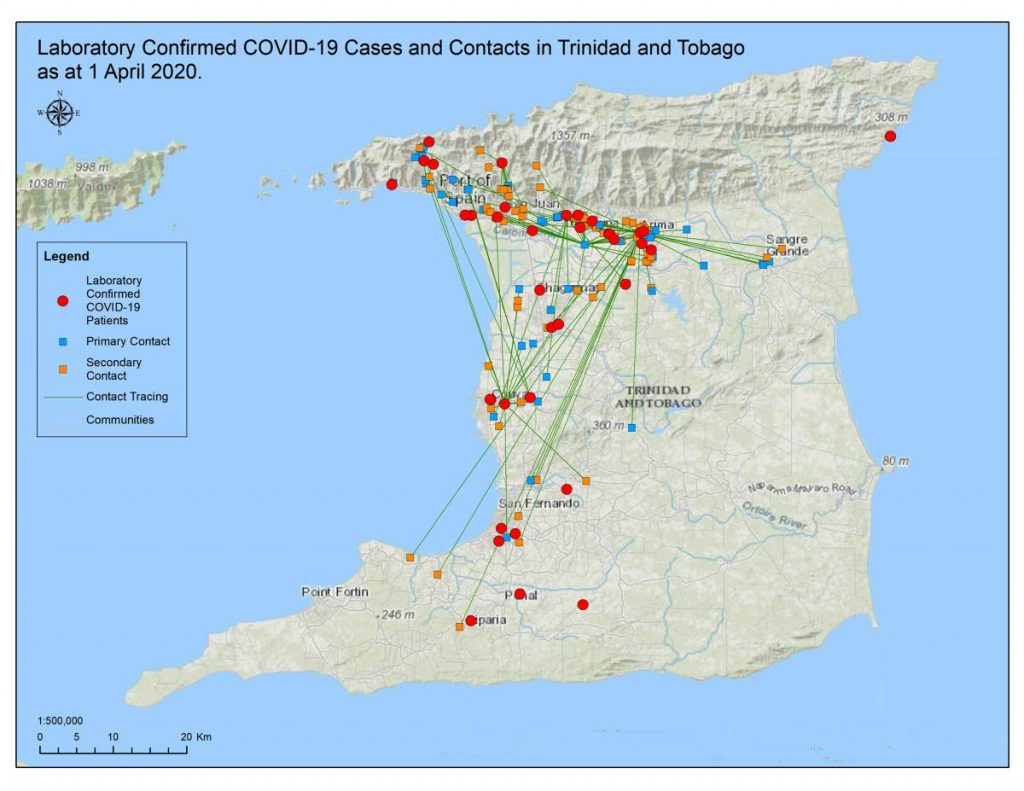COVID CORRIDOR

IF “X” marks the spot, red marks the spread!
At the daily Health Ministry virtual press conference on Thursday, a map was produced that showed, via red dots, the location of this country’s 94 confirmed covid19 cases.
Chief Medical Officer (CMO) Dr Roshan Parasram, explaining the map, noted clusters of covid19 cases, particularly along the East-West Corridor between Port of Spain and Arima.
In fact, most of TT’s covid19 cases thus far are concentrated along the corridor, with the exception of the Seventh-Day Adventist church camp in Balandra, northeast Trinidad. That was where all of the covid19 cases from one cruiseship are quarantined.
The map is part of the Geographic Information System (GIS) technology used to locate covid19 cases.
Health Minister Terrence Deyalsingh and Attorney General Faris Al-Rawi were also at the press conference.
The map’s legend indicates five differently-sized red dots, with the smallest denoting one covid19 case, and the largest, five. One red star indicates five-plus. The only star on the map is in Balandra, where the cruise ship passengers are.
Other areas of Trinidad with red dots are Chaguanas, Couva, San Fernando, Penal and Siparia. In Tobago, there are two dots on the western side of the island.
The GIS map is the “evidence base” that government will use to see where cases are, in order to better deploy resources and initiate contact tracing, to ensure quarantine measures to minimise the spread and flatten the covid19 rate-of-infection curve. Parasram also showed a second map to illustrate the chain of transition and potential spread.
While confirming there was local spread of the virus, he pointed out that almost all covid19 cases on the map are imported. He d would not identify which of the dots on the map were local cases.
The CMO said there is no way to track “hidden contacts,” and the only way to reduce the spread via asymptomatic cases is to strongly enforce and practise proper hygiene and social distancing.
“No country in the world can track their hidden contacts. That’s why we are taking stringent measures to ensure all the hidden contacts are reduced,” Parasram said. For now, the focus is on primary, secondary and tertiary contacts, he added, “that we know of and are tracked through GIS technology and other means.”
The second map showed the possible movement of some primary cases from the northwest which may have moved down the south of Trinidad, Parasram explained.
He cautioned that people who live in areas where there are no cases should not breathe a sigh of relief and become complacent.
“There is no limit of movement one case can have. There is the possibility of hidden contact and that is dangerous,” he warned. “There are persons who may have been contacted and are moving about freely and continue to do so.”
Health Minister Deyalsingh said at this moment, TT is at a stage where, if people refuse to follow the advice of government and new regulations under the Public Health Ordinance, the country’s health care system and resources could be overwhelmed. “I say this because international supply chains have been affected globally. All countries are competing for scarce resources.
“If the population doesn’t heed the warning to ‘stay home, stay safe,’ we will be in a bad position,” Deyalsingh said.
He added that his ministry is waiting for the first 100 cases, again excluding the 49 from Camp Balandra, before it can make any projections.
He said TT has between 160 and 170 ventilators, which “has us in a good position,” as data suggests a country should have five per cent ventilator capacity for the toal of its covid19 cases.
Thirty-seven of these ventilators are at the Couva Hospital and by next Tuesday, another 15 will be added, he said. This will bring TT up to the recommended five per cent capacity.
He stressed again, “While we are in a good position, if as a society we don’t conduct ourselves properly over the next couple of few weeks or few days, our best-laid plans will amount to nothing.”

Comments
"COVID CORRIDOR"